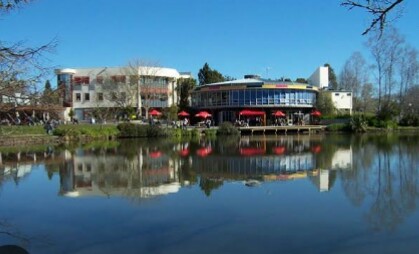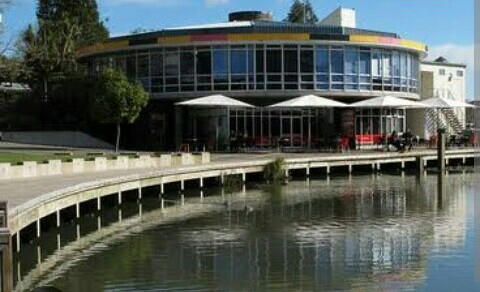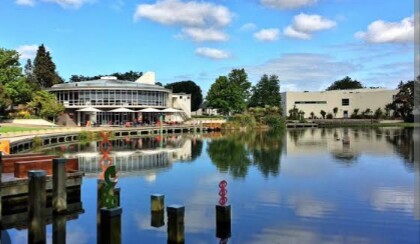Introduction University of Waikato
Nestled in the scenic region of Waikato, New Zealand, the University of Waikato has embraced sustainability as a core value and is leading the way in fostering a sustainable campus.
With a deep respect for the environment and a commitment to sustainable practices, the university has transformed its campus into a living laboratory for sustainability.
Through innovative initiatives, community engagement, and cutting-edge research, the University of Waikato exemplifies its dedication to creating a sustainable future. In this article, we will explore the sustainable practices and initiatives undertaken by the University of Waikato, highlighting its role as a champion of sustainability in higher education.
University of Waikato: Fact and Data
The University of Waikato, located in Hamilton, New Zealand, was established in 1964. It offers a diverse range of undergraduate and postgraduate programs across various fields, including arts, business, science, engineering, social sciences, law, and education.
The university is known for its strong focus on research and is home to several research centers and institutes. These centers cover areas such as environmental science, Māori and indigenous studies, computer science, health, and education.
With a diverse student population from both New Zealand and around the world, the University of Waikato provides a multicultural learning environment. It is particularly recognized for its commitment to Māori education and research, actively promoting Māori language, culture, and indigenous perspectives.
The university’s campuses, located in Hamilton, Tauranga, and other locations, offer modern facilities including libraries, laboratories, student accommodations, and sports facilities.
Through its research, knowledge dissemination, and community engagement, the University of Waikato contributes to the local community and society in general.
University of Waikato Sustainable Development
1. Sustainable Campus Design and Infrastructure:
The University of Waikato incorporates sustainable design principles into its campus infrastructure. Buildings are constructed with energy-efficient materials and feature innovative systems for heating, cooling, and lighting.
The university prioritizes passive design strategies, such as natural ventilation and daylight utilization, to reduce energy consumption. The campus also boasts green spaces, native plantings, and water-sensitive landscaping, creating a harmonious blend of nature and architecture.
2. Renewable Energy and Energy Efficiency:
The University of Waikato is committed to reducing its carbon footprint through the adoption of renewable energy sources and energy-efficient practices. The university has installed solar panels on several buildings, harnessing the abundant New Zealand sunlight to generate clean energy.
Additionally, energy-saving initiatives such as LED lighting, efficient heating and cooling systems, and smart building management contribute to significant energy reduction. By prioritizing renewable energy and energy efficiency, the University of Waikato serves as a role model for sustainable energy practices.
3. Waste Reduction and Recycling:
Waste reduction and recycling are integral components of the University of Waikato’s sustainability efforts. The university has implemented comprehensive waste management systems that include recycling stations across campus, composting initiatives, and programs to minimize single-use plastics.
The campus community is actively engaged in waste separation and responsible consumption practices. The University of Waikato strives to create a culture of sustainability that extends beyond campus boundaries.
4. Water Management and Conservation:
Water is a precious resource in New Zealand, and the University of Waikato recognizes the importance of water management and conservation. The university implements water-efficient technologies and practices, such as rainwater harvesting, water-efficient fixtures, and irrigation systems. The campus features water-wise landscaping and promotes water conservation education and behavior change.
By prioritizing responsible water management, the University of Waikato demonstrates its commitment to sustainability in a water-sensitive environment.
5. Biodiversity and Ecological Restoration:
The University of Waikato actively engages in preserving biodiversity and restoring ecological balance on campus. The university maintains natural areas, wetlands, and indigenous plantings, creating habitats for native flora and fauna.
Through research and conservation initiatives, the university contributes to understanding and protecting New Zealand’s unique ecosystems. The University of Waikato serves as a guardian of biodiversity, promoting environmental stewardship among its community.
6. Sustainable Education and Research:
Sustainability education and research are integral to the University of Waikato’s mission. The university offers a range of sustainability-focused courses and programs across various disciplines. Students have the opportunity to engage in research projects that address environmental challenges and contribute to sustainable solutions.
The University of Waikato actively collaborates with industry, government agencies, and local communities to tackle sustainability issues and create positive change.
University of Waikato: Renewable Energy Program
The Renewable Energy Program at the University of Waikato is an academic offering that focuses on educating students about sustainable and environmentally friendly energy sources and technologies.
This program is designed to provide a comprehensive understanding of various renewable energy options, including solar power, wind energy, hydroelectricity, geothermal energy, and more.
In this program, students are likely to study the technical aspects of renewable energy systems, exploring how they work, how energy is generated and stored, and how these technologies can be integrated into existing energy infrastructures. Students may also learn about the environmental and societal impacts of renewable energy adoption, energy policy and regulations, and the economic considerations associated with transitioning to cleaner energy sources.
The curriculum of the Renewable Energy Program may include a combination of theoretical courses, practical lab sessions, and potentially research projects. Students can expect to gain hands-on experience with renewable energy technologies, data analysis, and problem-solving skills related to designing, implementing, and managing renewable energy systems.
Whether at the undergraduate or postgraduate level, the program aims to prepare students for careers in the renewable energy sector, energy policy and planning, environmental consulting, research, and related fields. To obtain specific details about the courses offered, admission criteria, faculty expertise, and potential career pathways, it is recommended to visit the official website of the University of Waikato or contact the relevant academic department.
Conclusion University of Waikato
The University of Waikato stands at the forefront of sustainability in higher education, with its commitment to sustainable campus design, renewable energy, waste reduction, water management, biodiversity, and sustainable education.
By nurturing sustainability and environmental stewardship, the university prepares its students to become responsible global citizens who can address complex sustainability challenges.
As the University of Waikato leads by example, it inspires individuals, organizations, and communities to embrace sustainability and work towards a more resilient and regenerative future.
The University of Waikato’s dedication to sustainability extends beyond its campus boundaries. The university actively engages with the local community, forging partnerships and collaborations to drive sustainability initiatives in the wider region. Through community outreach programs, sustainability events, and knowledge-sharing platforms, the University of Waikato fosters a culture of environmental awareness and collaboration.
Moreover, the University of Waikato is a catalyst for sustainability innovation and research. Faculty members and students undertake groundbreaking research projects that tackle pressing sustainability issues, including climate change, biodiversity conservation, sustainable agriculture, and resource management. The university’s research contributions have the potential to inform policy decisions and drive positive environmental change at local, national, and international levels.
In addition to its internal sustainability efforts, the University of Waikato actively participates in sustainability networks and initiatives, both within New Zealand and globally. The university collaborates with other institutions, government agencies, and international organizations to share best practices, advance sustainability knowledge, and contribute to the global sustainability agenda. By actively engaging in these networks, the University of Waikato amplifies its impact and promotes the exchange of ideas and experiences to accelerate sustainability transitions.
In conclusion, the University of Waikato exemplifies a sustainable campus that integrates environmental stewardship, innovation, and community engagement. Through sustainable campus design, renewable energy, waste reduction, water management, biodiversity preservation, sustainable education, and research, the University of Waikato leads the way in fostering a more sustainable future. As the university continues to champion sustainability, it inspires individuals and institutions to adopt sustainable practices, embrace innovation, and contribute to the collective effort of building a resilient and thriving planet for future generations.
https://www.exaputra.com/2023/08/university-of-waikato-nurturing.html
Renewable Energy
I Know a Threat When I See One
 ICE agents have every reason to fear for their lives when protesters present this sort of nasty demeanor.
ICE agents have every reason to fear for their lives when protesters present this sort of nasty demeanor.
Renewable Energy
The East Wing
Here’s a beautiful piece of writing political commentator Rick Wilson the demolition of the East Wing of the White House.
Perhaps this is stupid question, but I need to ask it nonetheless: Does the president of the U.S. have the right to do something like this? I presume he doesn’t have a deed to the White House. As such, can he sell it? Build a Pizza Hut on the property?
How is this situation different than my walking across the street to the park, where I commence cutting down trees because they block my view of the mountains in the distance?
I would expect to be in handcuffs within a few minutes. Why? It’s not me property.
Renewable Energy
What the Destruction of the White House East Wing Means
 Here are a couple of remarks on Trump’s destroying the East Wing of the White House:
Here are a couple of remarks on Trump’s destroying the East Wing of the White House:
From Dan Rather
Witnessing any part of its demolition is a gut punch. Trump crossed an invisible line by destroying something that wasn’t his to destroy. You could say that about so much of what he has done, but the visual of seeing a bulldozer taking down part of this national treasure was a painful reminder of how he and his administration work every day at dismantling our democracy.
From the District of Columbia Preservation League
-
Climate Change2 years ago
Spanish-language misinformation on renewable energy spreads online, report shows
-
Climate Change2 months ago
Guest post: Why China is still building new coal – and when it might stop
-
Climate Change Videos2 years ago
The toxic gas flares fuelling Nigeria’s climate change – BBC News
-

 Greenhouse Gases1 year ago
Greenhouse Gases1 year ago嘉宾来稿:满足中国增长的用电需求 光伏加储能“比新建煤电更实惠”
-
Greenhouse Gases2 months ago
Guest post: Why China is still building new coal – and when it might stop
-

 Climate Change1 year ago
Climate Change1 year ago嘉宾来稿:满足中国增长的用电需求 光伏加储能“比新建煤电更实惠”
-

 Carbon Footprint2 years ago
Carbon Footprint2 years agoUS SEC’s Climate Disclosure Rules Spur Renewed Interest in Carbon Credits
-
Renewable Energy3 months ago
US Grid Strain, Possible Allete Sale














